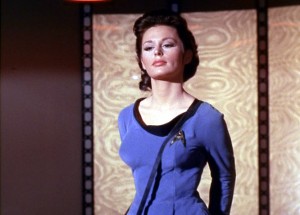Well first off, she’s a redhead, isn’t she? Redheads are special in science fiction. Nix that. Redheads are special, period. Science Fiction authors just get this basic, universal truth, carved as it was by God on the same stone tablets He used when he gave us the Declaration of Independence and the script for It Happened One Night. Ask Robert Heinlein or Alan Dean Foster. Redheads. Yeah.
Monthly Archives: April 2013
Review: The Child Thief by Brom
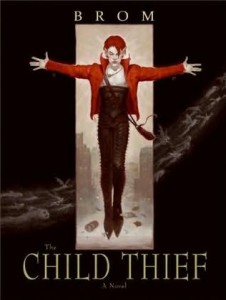 I said in my brief Goodreads entry on this book that it is “beautiful and disturbing,” and I think that’s the best tagline I can give it.
I said in my brief Goodreads entry on this book that it is “beautiful and disturbing,” and I think that’s the best tagline I can give it.
Fantasy artist Brom has created a dark version of Peter Pan, or, perhaps more accurately, he has re-imagined Peter Pan, highlighting some pieces which are vaguely referenced in J.M. Barrie’s original: the fact that there’s a lot of killing in Neverland, that Peter is a barbarian, a savage, and that there’s a strong possibility that when his Lost Boys become too old, Peter kills them or has them killed. All of this Brom details in his afterward. He also describes how he returned to Barrie’s original source material (or at least material that influenced him strongly), that being the legends and folktales of the British Isles.
A Traveler Between
by Beverly Volker
Art by Russell Volker, Sr.
Originally published in Beyond Orion #2 (July, 1977)
Bev and Nancy wrote for a lot of other zines over the years. As we find them, we’ll be posting those efforts here as well, in addition to stories and art from the pages of Contact. Here’s one of Bev’s short pieces about the aftermath of the accident which took Edith Keeler’s life in “City on the Edge of Forever.”
 The corridor was quiet and still, lights dimmed for the evening. At one end, a solitary figure waited in anticipation on the single bench. His vigil had been long. Finally, the sound of footsteps broke the silence and he rose anxiously to meet the approaching figure.
The corridor was quiet and still, lights dimmed for the evening. At one end, a solitary figure waited in anticipation on the single bench. His vigil had been long. Finally, the sound of footsteps broke the silence and he rose anxiously to meet the approaching figure.
“Mr. Kirk?”
The man from the bench nodded. “I’m Dr. Miles,” the other told him. He spoke gently. “I’m very sorry. There was nothing we could do for Miss Keeler. She suffered severe head injuries and some internal damage. I’m afraid she was too weak to survive the operation.” Continue reading
Beyond Orion
By Bev Volker
Originally Published in Beyond Orion #2
Stars beckon, calling,
Promising
Dreams come true.
Visions, silver-rimmed,
Fulfilled.
Out of the chaos of inhibitions,
Superstitions that keep us
Bound by our own inadequacy,
She rises
On wings of perception,
Understanding with intuitive insight,
The need to help.
Yet, Fate intervenes
Its insidious course,
Too soon.
She is right.
The time is wrong.
One day, Man will answer the starcall,
Soaring toward unlimited heights
Made possible by this
Sacrifice —
One insignificant life spent
In the infinite quest of destinies.
She must die.
He knows, Doctor. He knows.
The Art of Enterprise Regained
If you’re getting the impression that I’m just hopelessly stuck on myself, well, I hope you’re wrong. Can’t swear to it. It’s just that I’ve put a lot of time and energy lately into preserving the work that a lot of people, myself included, did back in the 1970s and 1980s, and so I’m thinking of a lot to say about it. And, yeah, I think our work deserves to be remembered. So there it is, and here’s a rundown of the artistic effort that went into making my first fanzine, lo those three decades ago.
Fanzines in the 1980s had amazing artwork, not always done justice by the printing technologies fan publishers were forced to use. When I decided to publish my own zine in 1984, I wanted it to have its share of artwork. Being a one-man-show, I had to provide my own. Fortunately, in those days, illustration was something I did. I’d also worked on the school newspaper and yearbook, so I was comfortable with publication design.
For the zine’s cover, I couldn’t afford color. I was publishing on my parents’ office Xerox machine! So I xeroxed a photo of the Enterprise (I think from the STTMP Souvenir Program Book center spread), trimmed with scissors and pasted over the Starfleet Delta, which I formed with 4pt layout tape on thin graph paper:
I printed it on canary yellow paper. All copies with this cover were printed at home on my parents’ office copier, and all artwork was thus reproduced from the original by Xerox.
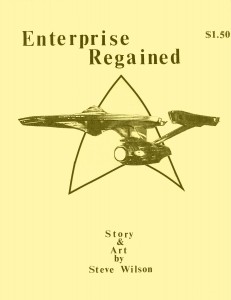 I did 25-50 copies of this one, and then my parents said “enough.” If I was going to mass-produce, I needed to do it right and go to a real printer. I pulled out the phone book and, appropriately, picked Galaxy Graphics to do my offset printing. They were going to halftone all my illustrations, so I designed a new cover.
I did 25-50 copies of this one, and then my parents said “enough.” If I was going to mass-produce, I needed to do it right and go to a real printer. I pulled out the phone book and, appropriately, picked Galaxy Graphics to do my offset printing. They were going to halftone all my illustrations, so I designed a new cover.
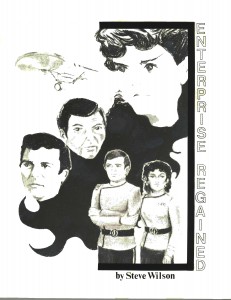 This is a scan of the original master for the second cover. I though it was better to emphasize the people, rather than the ship, and make it clear this was a Saavik story. This master used a half-tone of my original, which was charcoal. Haven’t found that artwork yet, but hope to, as the half-tone lost some of the detail. Copies with this cover have half-tones of my original pencils on the interior. I believe 200 copies were printer. Maybe 400?
This is a scan of the original master for the second cover. I though it was better to emphasize the people, rather than the ship, and make it clear this was a Saavik story. This master used a half-tone of my original, which was charcoal. Haven’t found that artwork yet, but hope to, as the half-tone lost some of the detail. Copies with this cover have half-tones of my original pencils on the interior. I believe 200 copies were printer. Maybe 400?
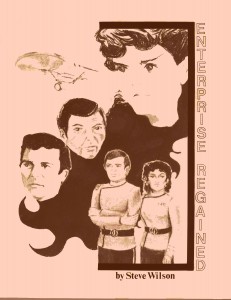 When that batch sold out, I decided the cover needed some color, so I made it tan. For this edition, to save money, I went with pen and ink for the interior illos.
When that batch sold out, I decided the cover needed some color, so I made it tan. For this edition, to save money, I went with pen and ink for the interior illos.
And then the illos…
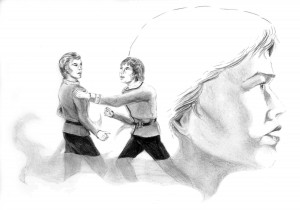 The first illustration I ever did of Kevin Carson (left) and Terry Metcalfe in their original Trek context. This was pencil on a page from my sketchbook. I later did a pen and ink version, tracing it on a light table. I was never as happy with that one. The smoky-looking constructs show the influence Richard Powers had on me at the time. I was so taken with his illustrations for Heinlein’s Number of the Beast.
The first illustration I ever did of Kevin Carson (left) and Terry Metcalfe in their original Trek context. This was pencil on a page from my sketchbook. I later did a pen and ink version, tracing it on a light table. I was never as happy with that one. The smoky-looking constructs show the influence Richard Powers had on me at the time. I was so taken with his illustrations for Heinlein’s Number of the Beast.
 This two-page spread of Uhura and Chekov went across the opening pages of Chapter Four. I was a little baffled when I found the box of nearly all my zine illos, and these two weren’t there. I was even more surprised when I pulled the file of master pages for this zine after all these years and found the drawings had been done right on the master pages! My art teacher, Steve Perrine, taught me better than that! But I guess I was in a hurry. There are actually three sets of masters for this thing. I first typed on 8.5 x 11 paper with NO margins, then reduced those by 70% (the Xerox only did 94, 70 and 50, I think) to create masters for copying. When I went to offset and used half-tones, yet a third set of masters had to be created with the half-tones pasted on them. These were pencil on the characters, with the views of space behind them done in charcoal for extra contrast. Again, there’s a pen and ink version.
This two-page spread of Uhura and Chekov went across the opening pages of Chapter Four. I was a little baffled when I found the box of nearly all my zine illos, and these two weren’t there. I was even more surprised when I pulled the file of master pages for this zine after all these years and found the drawings had been done right on the master pages! My art teacher, Steve Perrine, taught me better than that! But I guess I was in a hurry. There are actually three sets of masters for this thing. I first typed on 8.5 x 11 paper with NO margins, then reduced those by 70% (the Xerox only did 94, 70 and 50, I think) to create masters for copying. When I went to offset and used half-tones, yet a third set of masters had to be created with the half-tones pasted on them. These were pencil on the characters, with the views of space behind them done in charcoal for extra contrast. Again, there’s a pen and ink version.
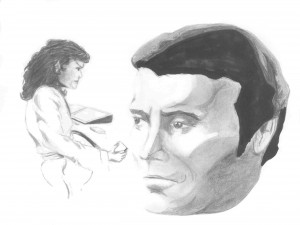 I was never happy with this drawing. Again drawn directly on the masters, and the Kirk head was actually cut and pasted in place. I have a vague recollection that there was another, botched Kirk head under it. Or maybe a figure of Kirk that actually fit in the scene. As it is, I decided pretty quickly that I thought the effect was just bizarre. I still like the drawing of Saavik in her robe, though. You’ll note that all the Saavik images are based on Robin Curtis, even though the story was written and the publication almost complete before she ever played the part. I took an immediate liking to her as Saavik. I think it’s a shame that people only seem to remember Kirstie Alley now. I’ve met and worked with Robin several times over the years, and she’s a fun and friendly person.
I was never happy with this drawing. Again drawn directly on the masters, and the Kirk head was actually cut and pasted in place. I have a vague recollection that there was another, botched Kirk head under it. Or maybe a figure of Kirk that actually fit in the scene. As it is, I decided pretty quickly that I thought the effect was just bizarre. I still like the drawing of Saavik in her robe, though. You’ll note that all the Saavik images are based on Robin Curtis, even though the story was written and the publication almost complete before she ever played the part. I took an immediate liking to her as Saavik. I think it’s a shame that people only seem to remember Kirstie Alley now. I’ve met and worked with Robin several times over the years, and she’s a fun and friendly person.
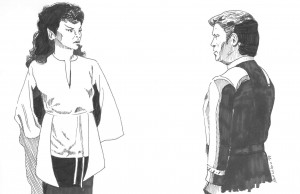 Since I wasn’t happy with the first, I replaced it with this one when I went pen and ink. A dubious trade-off, I think, since this isn’t nearly as nice a drawing of Saavik!
Since I wasn’t happy with the first, I replaced it with this one when I went pen and ink. A dubious trade-off, I think, since this isn’t nearly as nice a drawing of Saavik!

Looking back, it’s probably a mistake that there’s no illustration of Angela Teller. I think, had there been, a lot less people would have believed I had created the character for this story. She was, after all, the same lady who appeared in the episodes “Balance of Terror,” “Shore Leave” and “Turnabout Intruder.” I just always liked her, so I put her aboard the new Enterprise.
Announcing the Arbiter Logs
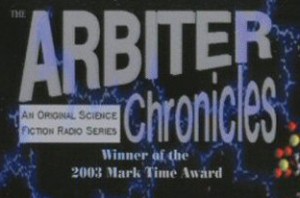 This morning I put the last 2300 words to the third novella I’ve written in 2013. And now at 75% of the way to the home stretch on this leg of my project, here’s what I’m up to: With eBooks taking off and moving, outstripping my paper book sales, I’ve decided that the sixteen or so Arbiters adventures that exist only as audio dramas should be available to readers as well. I’d always intended to novelize these scripts and print them, three of four to a book, as the adventures of young Horatio Hornblower are presented in Mr. Midshipman Hornblower, and as Alan Dean Foster did in the wonderful Star Trek Logs.
This morning I put the last 2300 words to the third novella I’ve written in 2013. And now at 75% of the way to the home stretch on this leg of my project, here’s what I’m up to: With eBooks taking off and moving, outstripping my paper book sales, I’ve decided that the sixteen or so Arbiters adventures that exist only as audio dramas should be available to readers as well. I’d always intended to novelize these scripts and print them, three of four to a book, as the adventures of young Horatio Hornblower are presented in Mr. Midshipman Hornblower, and as Alan Dean Foster did in the wonderful Star Trek Logs.
My eBook sales reports say the time is right to build up my inventory, so, by Summer, my plan is to release the first four Arbiter Chronicles adventures as novellas, for sale in eBook form at the reasonable price of 99 cents each. “Mutiny Springs Eternal,” the Mark-Time-Award-wining “A Man Walks Into a Bar,” and “Man of Letters” are drafted and ready for me to polish and send to the editor. I’ll embark on “The White Lady” next, and expect to have it finished in two to three weeks, in time to craft an outline for the third volume of ReDeus before Balticon. I’m really excited about this. It’s a chance to revisit my favorite characters in stories I told a dozen years ago. Along the way, I’m adding new insights and texture. I’m hoping this will bring the Arbiters to a whole new audience, and I hope all of you who’ve made this journey with me so far will come along for the ride.
REVIEW: House of Zeor
 Jacqueline Lichtenberg has played a big part in the lives of science fiction fans. Not just creative fans who write fan fiction or produce their own media content, though she is a pioneer of fan fiction as we know it now, but also of any fan who now enjoys the organized chaos that is Fandom, as experienced at conventions or on the Internet. But let me tell it to you as I lived it. Do I ever tell it any other way?
Jacqueline Lichtenberg has played a big part in the lives of science fiction fans. Not just creative fans who write fan fiction or produce their own media content, though she is a pioneer of fan fiction as we know it now, but also of any fan who now enjoys the organized chaos that is Fandom, as experienced at conventions or on the Internet. But let me tell it to you as I lived it. Do I ever tell it any other way?
In 1973, I was eight years old and a huge Star Trek fan. It was always on television, usually twice a day. Except for a brief dry spell when an episode about possession called “The Lights of Zetar” scared me so badly that I could neither eat nor sleep for a while, I watched it faithfully. My brother had been a fan even longer. He was, after all, eight years old when the show premiered. I was just a baby at the time, so I had to catch up later. I still remember the night I discovered, on my brother’s book shelf, seven paperbacks labeled Star Trek 1 – 7. They contained short prose renderings of the episodes by noted SF author and critic James Blish. My favorite show? In book form? I was hooked. For several years, I read nothing but Blish’s Star Trek and Greek Mythology. Hadn’t yet discovered comic books.
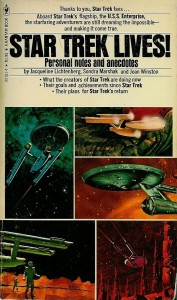 I bought Trek volumes 8 – 11 as they came out. Somewhere in there, Bantam, the publisher, released something called Star Trek Lives. It had the cover art from most of the Blish novels on it, so I bought it. I wasn’t sure what it was. It wasn’t short stories. It wasn’t a novel. At that age, I wasn’t too big on tearing into a non-fiction book that was over 200 pages long, but I skimmed. A section titled “Do it yourself Star Trek” sounded interesting. I read that. It seemed that a lot of people–adults, not just kids!–liked Star Trek so much that they were writing their own stories and publishing them in things called fanzines. I was fascinated. There were also clubs, and some things called “conventions.” That was a big word, and very daunting. I hadn’t a clue what it meant, but gosh it sounded important. And there was an organization, the Star Trek Welcommittee, which helped fans keep track of where all this stuff happened, when it happened, and how you could be part of it. Jacqueline Lichtenberg was a co-author of the book, an author of a lot of that “do it yourself Star Trek,” and founder of said Welcommittee.
I bought Trek volumes 8 – 11 as they came out. Somewhere in there, Bantam, the publisher, released something called Star Trek Lives. It had the cover art from most of the Blish novels on it, so I bought it. I wasn’t sure what it was. It wasn’t short stories. It wasn’t a novel. At that age, I wasn’t too big on tearing into a non-fiction book that was over 200 pages long, but I skimmed. A section titled “Do it yourself Star Trek” sounded interesting. I read that. It seemed that a lot of people–adults, not just kids!–liked Star Trek so much that they were writing their own stories and publishing them in things called fanzines. I was fascinated. There were also clubs, and some things called “conventions.” That was a big word, and very daunting. I hadn’t a clue what it meant, but gosh it sounded important. And there was an organization, the Star Trek Welcommittee, which helped fans keep track of where all this stuff happened, when it happened, and how you could be part of it. Jacqueline Lichtenberg was a co-author of the book, an author of a lot of that “do it yourself Star Trek,” and founder of said Welcommittee.
Flash forward a few years, because I did discover comic books, and they consumed my imagination for a while. I did write some of that “do it yourself” fiction–a lot of it!–between third and ninth grade, but it was largely focused on the Justice League of America, the Legion of Super-Heroes, and an upstart show called Space:1999. I recall trying to write some Avengers and X-Men, but they were a little above the level of someone my age. I started a Star Trek / Space:1999 crossover, but never got beyond the outline stage. (In case you’re curious, the Moon, was going to drift into the Delta Triangle with the Alphans in suspended animation, where the Enterprise would find it after being catapulted there by a resurrected Gary Mitchell. That’s all I remember. I drew a lot of concept sketches. If you don’t know what the Delta Triangle is, you need to put yourself on a self-study course in remedial Trek history, which includes the Animated series.) None of this was ever read by anyone outside a circle of two or three teachers and friends.
It wasn’t until Star Trek was resurrected and then re-resurrected by Harve Bennett and Nick Meyer with The Wrath of Khan that I got serious about this fan fiction business, as I’ve recently chronicled. When I did get serious, I had to figure out where I could send this stuff to have it included in a zine, or, publishing it myself, how I could let people know it existed. I remembered, several years before, reading about something called a Welcommittee. Did it still exist? Why yes it did. It advertised regularly in Starlog. (I think! Maybe it was listed in the Best of Trek books? I read all those, too.) I wrote to the Welcommittee and got a copy of their latest newsletter, as well as a guide about writing, publishing and buying fanzines which was written by Judith Segal. The Welcommittee newsletter helped me find cons to attend, zines to submit to and generally catapulted me into Trek Fandom proper.
Somewhere in there, I sent some of my fan fiction to Judy. She was very friendly and encouraging to me, sending me a critique and giving me solid advice about developing fiction. On the whole, Trek fans and the creative community among them seemed like a group of very nice, very encouraging people. Even as a teen, I appreciated that efforts of people like Jacqueline, who had taken the time to not only build an established Fandom around their favorite TV show, but to create ways in which new fen could join the party.
A couple of years later, in the college bookstore (where I went pretty much daily–it had a fantastic selection of SF books!) I found a book called Channel’s Destiny, but Jean Lorrah, who’d written a really enjoyable Trek novel about Sarek and Amanda, and Jacqueline Lichtenberg. I figured I’d enjoy it, but, for some reason, I never read it. Over the course of the next almost thirty (ulp!) years, I became aware that Jacqueline had created her own universe, people by the Simes, the Gens and the Channels. She’d written many books in that series, and all those I knew in the Trek and fan fic communities had great respect for them. They were on my mother-in-law’s shelves, and spent several years in my house, while her home was in transition and after her death. They went on to her sister, me still not having read them.
I was also aware that my friend Martha, founder of a filk group called The Omicron Ceti Three, had written at least one song inspired by the Sime-Gen series. (Again, if you don’t know what filk is, remedial course. Seriously.) It was because of Martha’s song that I finally read some of Jacqueline’s works of fiction. You see, because I had started a web site archiving the fanzine Contact, my mother-in-law’s significant contribution to fannish history, Jacqueline was referred to me as someone who could put her in touch with Martha, a major contributor to Contact. She wanted to discuss the use of Martha’s song “Two Kinds of Man” in marketing a game based on her still-thriving series. In the course of this discussion, I was reminded that I’d never read the work of this important figure in a movement in which I’ve spent over thirty years of my life actively participating.
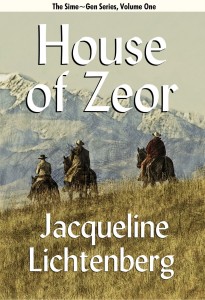 I searched out her website, simegen.com, where I was able to read her first Trek story set in the Kraith universe. (I’ve since discovered I actually have the first collected volume she published, back in the 1970s.) That was well-written and thought-provoking; so, in keeping with my quest to discover good books that were published before Twilight and Harry Potter, I sought out House of Zeor, the first volume in the Sime-Gen series. I just finished it this weekend.
I searched out her website, simegen.com, where I was able to read her first Trek story set in the Kraith universe. (I’ve since discovered I actually have the first collected volume she published, back in the 1970s.) That was well-written and thought-provoking; so, in keeping with my quest to discover good books that were published before Twilight and Harry Potter, I sought out House of Zeor, the first volume in the Sime-Gen series. I just finished it this weekend.
The story is set on earth centuries in the future. The human race as we know it no longer exists. It has been replaced by two new offshoots, the Simes and the Gens. The Gens are almost–almost!–like we are today. Their bodies, however, produce selyn, a substance which is the quintessence of their life force. Drain it all from their bodies, and they die. The Simes are a bit more exotic. In addition to the usual human limbs, they have tentacles ensheathed on their forearms. These are wonderful for manipulating things in ways that regular hands cannot, but they are primarily intended to be used as collectors, harvesting selyn from the only source available: Gens. When a Sime feeds off a Gen, the Gen dies. If the Sime doesn’t get selyn, the Sime dies.
It sounds a bit like a vampire analogy at first, but it’s not that simple. There are also Channels, Simes who are capable of siphoning off selyn from Gens without killing them, and then sharing it with other, non-Channel Simes. Channels are the key to a possible future cooperation between the two races, and, indeed, it’s a cooperation which must happen. Zelerod, a Sime mathematician, has run the numbers and concluded that, at the current rate of breeding and consumption, there will eventually be no more Gens to feed from, and all of humanity will die out.
The action gets off to a running start: Hugh Mallory is a Gen detective, assigned to find a government official who’s been kidnapped in a raid by Simes. The official, Aisha, happens to also be the woman he’s in love with. Hugh is working a police job only as a living, until retirement. By calling he’s an artist, and Aisha is his model and his muse. In order to get safely into Sime territory and search for Aisha, he’s got to work with an actual Sime. He’s introduced to Klyd Farris of Householding Zero. Klyd is a Channel on a mission to bring about an era of peace and symbiosis between Simes and Gens. Because the kidnapping of Aisha could lead to the fall of the Gen government, hindering his efforts, he agrees to take Hugh with him and find her. Neither of them is wild about this idea.
So it’s a buddy cop story where one cop is a vampire? No, again, it’s not that simple. Rather than Hugh and Klyd learning to tolerate and trust each other well enough to work together, stop the bad guy and save the girl, Hugh actually becomes immersed in Klyd’s householding, their lives become intertwined, they become family. We learn there are several householdings, all led by Channels, where Simes and Gens live together in peace because the Channels allow the Simes to feed without killing the Gens. We also learn that Hugh’s mother is a Gen slave who escaped Sime territory many years passed, so he knows a bit more about the culture than he sometimes lets on.
I was struck by the strong feel this book has of true Seventies SF. There was no other time quite like the Seventies for SF, when the stories combined powerful hope for the future and a sense of morality with a bleakness and a grittiness that brought a sense of reality. I was (and still am) a huge fan of Logan’s Run in all its incarnations, and House of Zeor made me nostalgic for the short-lived TV series (story edited by Trek’s DC Fontana) in the way it put a stranger (Hugh) in a strange land (Zeor) and let him discover it in a relatively gentle way, evoking a real sense of peace and a sincere quest for knowledge.
But this story is not all nostalgia. I found its topics still relevant, now, perhaps, in ways Jacqueline didn’t have in mind as she wrote it. The Channels, Simes who don’t want to kill Gens, are considered “Perverts” by both other Simes and Gens. Not too many works of the period were so forward-thinking as to cast the people who are clearly the good guys in such a role, using a completely negative term like “pervert” to refer to them again and again. Of course, now we’re very accustomed to hearing people who are trying to change the world for the better called “perverts.” Sadly, that’s the response of some of us to attempts to update marriage customs to allow two people of the same sex to be wed. For us today, there’s a very clear gay marriage analogy. But this was written at a time when the word “gay” had just come into use, and there was quite a battle to attach any sort of a positive meaning to it in the minds of the non-gay segment of the public. Acceptance of homosexuality itself was just working its way into public consciousness. It would be decades before the time would be ripe to talk about marriage equality.
Indeed, the story skirts around the topic of homosexuality. There’s a brief mention of it among the Simes, and we’re led to believe it’s tolerated, but no more. Interestingly, in order to complete selyn transfer, the Sime and the Gen must touch at five points: two tentacles to the left arm, two to the right arm, and mouth to mouth. Since most of the transfers are between men, there’s an automatically homoerotic context, but it’s explained that there is nothing sexual about this kiss. That’s not to say that it doesn’t explore the elements of love and friendship, even family ties, between men. Trek fan fiction has a long history of delving into those themes, and it shows here.
I appreciated the texture of the Sime and Gen cultures as we learned about them. There’s a North / South dichotomy established, such as existed during the War Between the States. Klyd tells Hugh: “We have photography, fertility drugs, some rudimentary electronics, and a certain expertise in chemistry. You have industries based on mass production, mathematical sociology, and assorted fundamental attitudes totally lacking with us.” The quote reminded me of the differences between the industrial Union and the agrarian Confederacy. It adds to the sense of realism in the story. (The welcome Hugh receives among the Simes also reminded me of an old children’s book, Rifles for Watie, in which the young protagonist is received into the enemy camp and met with unexpected kindness. Such golden-rule-based treatment serves to undermine the spirit of war.)
This is a short novel, and clearly there is much backstory: Hugh’s past and the Gen experience in Sime territory, Klyd’s marriage to a Gen, and how it came to be, the nature of the Gen government… all of these are touched on, but there’s no time to explore them. It’s evidence of an author who put a lot of thought into creating a fully realized world. It’s also a good way to encourage further readership. Fortunately for the so-encouraged, I’m told there are eleven more volumes in the series, and the creators are still going strong.
Contact 04
Se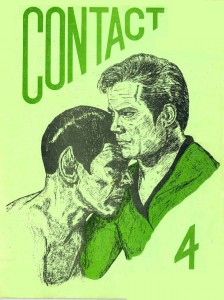 ptember, 1977. Star Trek had been off the air for eight years. A movie was still over two years away. Papers had announced the development of Star Trek: Phase II, a series which never happened and which, surprisingly, the Contact crowd, so close to the center of Fandom, was apparently unaware. At least Bev swore up and down in the 1990s that she’d never heard of the show, and would have remembered if Roddenberry had used the name of her Trek sequel for his own.
ptember, 1977. Star Trek had been off the air for eight years. A movie was still over two years away. Papers had announced the development of Star Trek: Phase II, a series which never happened and which, surprisingly, the Contact crowd, so close to the center of Fandom, was apparently unaware. At least Bev swore up and down in the 1990s that she’d never heard of the show, and would have remembered if Roddenberry had used the name of her Trek sequel for his own.
At this point, Bev and Nancy seemed to have hit a creative wall. They announce in their editorial that there may be no Contact 5. They apparently felt in a rut, dismissed as a “get em” zine (a serious charge for fan fiction in the 1970s!) and even unsupported by fans and fellow creators who weren’t sending them the diversity of material they felt they needed. They felt there was too much torture, too much Hurt-Comfort, in their pages. It’s a point all creators seem to reach. As the historical drama of Contact unfolds, it’s heartening to know it didn’t stop Bev and Nancy. They still had years and issues ahead of them.The cover is designed and drawn by Russ Volker, probably one of his most striking designs. The table of contents page lists a half dozen fan fiction legends, not even counting the editors.
This issue contains “The Rack,” a piece by J. Emily Vance which is billed in Bev’s and Nancy’s notes and in other sources as the first “response fic,” the first story to be written in response to discussions happening in Fandom. Ripped from the headlines, as it were. The discussion was whether or not Kirk and Spock were, in fact, lovers. “The Rack” speculates (horribly) on what impact such discussions can have on the lives and careers of real people. No one had heard of J. Emily Vance before. In fact, “she” didn’t exist. The name was a corrupted anagram of parts of the names of the three actual authors: “J Em” for Martha J. Bonds, “ily V” for Bevily Volker, and “ance” for Nance-y Kippax.
Here are the links to the PDF and CBZ files.
This issue contains:
BACK WHERE HE BELONGS (poem) by Crystal Ann Taylor; illo by Laurie Huff
THE ONLY OTHER THING (story) by Ginna Lacroix; illo by Merle Decker
THE CHALLENGE (poem) by Nancy Kippax; illo by Russ Volker
BORN OF ASHES (novella) by Martha J. Bonds; illos by Pat Stall
MOVING (poem) by Pete Kaup; illo by Kathy Carlson
INTERLUDE (poem) by Bev Volker; illo by Judd
THE WRITING CONTEST: THE WINNERS
SITUATION HELP by Karen Moody
THE SADISTS by Sheila Clark
END RESULT by Shirley S. Maiewski
NEW CONTEST
THE CHANGELING (poem) by Martha J. Bonds; illo by Kathy Carlson
SUN GOD AND SHADOW (poem) by Amy Falkowitz; illo by Signe Langdon
THE HUNGER IN THE MOUNTAIN (story) by Jennifer Weston; ilLos by Leslie Fish
THE NATURE OF LOVE (poem) by Martha J. Bonds
R’VAMO (poem) by Susan K. James; illo by Signe Landon
THE REAL THING (story) by S. Schildknecht & M. Bonds
REVOLUTIONS (poem) by B. J. Volker; illo by Signe Landon
SENSORY PERCEPTION (poem) by Carolyn Venino; illo by Merle Decker
THE RACK (novella) by J. Emily Vance illos by Alice Jones
SO CONSTANT THE CHANGE (poem) by Beverly Volker
WE REACH (Ads)
Prometheus + Firebringer = One MILLION Downloads!
 Sometime earlier today or last night, downloads of our combined podcast feeds for Prometheus Radio Theatre, plus our Firebringer titles at PodioBooks.com, hit the One-Million mark. While we’re sure a lot of our colleagues out in podcast-land hit this milestone long ago, we’re pretty excited. We don’t know which show or chapter was the one millionth, but we do know that our single “best-selling” download is Steve’s reading of “The God of Tarzan,” and our most-downloaded work is still Taken Liberty. These numbers don’t include any of the audio we’ve provided to libraries, or to BooksAMillion.com, or the stats for Badge of Infamy via LibriVox; so our actual numbers are even higher. Thanks for listening, please keep listening, and tell, maybe, another million friends!
Sometime earlier today or last night, downloads of our combined podcast feeds for Prometheus Radio Theatre, plus our Firebringer titles at PodioBooks.com, hit the One-Million mark. While we’re sure a lot of our colleagues out in podcast-land hit this milestone long ago, we’re pretty excited. We don’t know which show or chapter was the one millionth, but we do know that our single “best-selling” download is Steve’s reading of “The God of Tarzan,” and our most-downloaded work is still Taken Liberty. These numbers don’t include any of the audio we’ve provided to libraries, or to BooksAMillion.com, or the stats for Badge of Infamy via LibriVox; so our actual numbers are even higher. Thanks for listening, please keep listening, and tell, maybe, another million friends!
Review – Uncanny Avengers #5
 I’ve made no secret of the fact that I’m not much of a fan of modern comics. I don’t like the pace of the storytelling, where everything is so obviously plotted to fill a six-or-twelve-issue trade. Often nothing significant happens in a single month’s issue, and even more often, the thirty-day wait between issues in which the plotting is more suited to a daily soap opera causes me to forget what happened before, and I lose the thread of the story entirely. This is intentional, I’m sure. Comics publishers want buyers to pick up the individual issues to stuff in bags and collect, and save reading for the trade paper edition, which they think we’ll also buy. Stupidly, a lot of us do buy each issue and the collected edition that comes out within days after the final issue of a story arc. Indeed, sometimes the trade beats the final issue to the stands.
I’ve made no secret of the fact that I’m not much of a fan of modern comics. I don’t like the pace of the storytelling, where everything is so obviously plotted to fill a six-or-twelve-issue trade. Often nothing significant happens in a single month’s issue, and even more often, the thirty-day wait between issues in which the plotting is more suited to a daily soap opera causes me to forget what happened before, and I lose the thread of the story entirely. This is intentional, I’m sure. Comics publishers want buyers to pick up the individual issues to stuff in bags and collect, and save reading for the trade paper edition, which they think we’ll also buy. Stupidly, a lot of us do buy each issue and the collected edition that comes out within days after the final issue of a story arc. Indeed, sometimes the trade beats the final issue to the stands.
( Collapse )
I was cautiously optimistic when it was announced that a new book called Uncanny Avengers was coming out. It had a cast featuring both Avengers and X-Men, and it prominently featured Marvel second-stringers Havok, Rogue and Scarlet Witch alongside Captain America, Thor and the annoyingly omnipresent Wolverine. I was, unfortunately, so disappointed with the opening four-issue story arc that I was going to stop reading the book. It was full of characters blaming the Scarlet Witch for the fact that she was badly written by Brian Michael Bendis, it featured the corpse of Professor X being hauled around with the top of his head missing, and it featured unnamed characters being killed with no notice or mourning. It just wasn’t what I wanted to read.
My son asked me to read the latest issue, however, because the ending bothered him and he wanted to discuss it. So I read it, and I have to say it’s the best in the series, probably the best issue of anything with Avengers in the title that’s been published in years. (Although Dan Slott tried hard on his run on Mighty Avengers to re-capture some of the greatness of years past.) There’s a scene with Captain America and the Scarlet Witch the likes of which we haven’t seen since Roy Thomas wrote the book in the 1960s, and it’s refreshingly free of reminders that she allowed herself to be used by super villains to perpetuate bad Summer “event” storylines. There’s a seen where Wolverine recruits Sunfire to the team, in which Wolverine is, for the first time in thirty years, not annoying to me. (Granted there’s a detour into an account of how he just drowned his son in shallow water and buried him that I could have done without. As a parent, I really hate how often comic heroes children are killed, especially by their own parents. It suggests that the creative teams are either very young, stupid and single, that they’re middle-aged get-a-lifers in no danger of having a child, or that they’re screwed up people who really hate their kids.)
I won’t give the details of the ending and how it bothered my son. Suffice to say it involves death and surprise, but I pretty much glossed over it. It’s an easily undone death. The issue was low on shock, high on characterization, and featured the return of light-hearted characters Wonder Man and the Wasp. It bodes well for the future of the series.
But my favorite part involved Havok, brother of Cyclops of the X-Men. Cyclops is now a murderer and a super villain, because, again, we love our moral relativism. The point of the team he leads is to foster unity between “normal” humans and mutants. After shooting down an offensive suggestion by Captain America that they hide their more notorious mutant members for a while (remember that Cap took orders from a Commander-in-Chief who thought it was acceptable to put US citizens in relocation camps based on how they looked), Havok tells members of the press that he would prefer they stop using the “M-word” and just refer to the mutant members of society as people, with no special labels. When the dimwit reporters ask, “Well then what do we call you?” (because dimwit reporters can’t live without labeling people) he responds, “Call me Alex.”
It’s a wonderful rejection of group-think. Havok is standing up and saying, “I’m a person, not a label. Don’t use the label, because it tends to make you think of me as something other than a person. My identity is mine, not some group’s, and you may call me by the name which identifies one unique individual.” Such individuality is refreshing in a day when we only seem to want to recognize people as parts of groups, not as individuals.
I understand this speech has created controversy, that it’s seen as Havok rejecting his mutant identity, that he’s ashamed of what he is, that he’s like a gay person going back in the closet. I don’t buy that. There’s a time for claiming a label and saying, “Why yes I am this thing or that thing, and I am proud of it.” There’s also a time for saying “that adjective you use to describe me is a part of my identity. It is not my whole identity. If it gets in the way of you treating me as an equal, then don’t use it.”
I support marriage equality, and I appreciate the thoughtful arguments of friends who think it’s appropriate to keep using the term “gay marriage,” so that we don’t forget what it is that some people are trying to deny, even though we don’t say, “I’m getting straight married.” I think that’s a good point. But that’s labeling a concept, a practice, not a person.
Labels are dangerous, because people become obsessed with them. They make it too easy to pre-judge and say, “That person meets this criteria, so I can dislike him without investigating further.” That’s something we shouldn’t allow ourselves to say. The speech made by Havok herein makes a stab at letting people know that, and I congratulate the writer, Rick Remender. Keep writing issues like this one, Rick, please!

